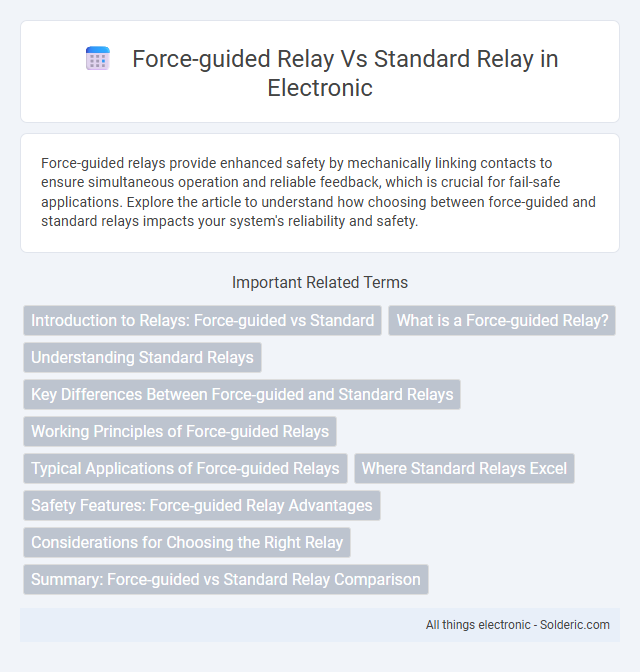Force-guided relays provide enhanced safety by mechanically linking contacts to ensure simultaneous operation and reliable feedback, which is crucial for fail-safe applications. Explore the article to understand how choosing between force-guided and standard relays impacts your system's reliability and safety.
Comparison Table
| Feature | Force-guided Relay | Standard Relay |
|---|---|---|
| Contact Mechanism | Mechanical interlock ensures contacts move together | Independent contacts, no mechanical interlock |
| Safety | Enhanced safety with forced guidance, prevents unsafe states | Lower safety, contacts may not reflect relay state |
| Applications | Safety circuits, emergency stops, fail-safe systems | General switching applications |
| Cost | Higher initial cost due to safety features | Lower cost, basic switching |
| Reliability | High reliability, contacts confirmed by mechanical link | Standard reliability, no guaranteed contact status |
| Standards Compliance | Complies with safety standards (e.g., IEC 60947-5-1) | May not meet stringent safety standards |
| Contact Feedback | Positive feedback on contact position | No feedback on contact position |
Introduction to Relays: Force-guided vs Standard
Force-guided relays, also known as mechanically linked relays, ensure all contacts move simultaneously, providing reliable feedback on relay status critical for safety applications. Standard relays operate independently per contact, which can result in undetected contact failures, making them suitable for general control tasks where safety feedback is less paramount. Understanding the mechanical distinction between force-guided and standard relays is essential for selecting the appropriate device in industrial automation and safety system designs.
What is a Force-guided Relay?
A Force-guided Relay uses mechanical linkages to ensure that all contacts move together, providing reliable feedback on the relay's status for enhanced safety in control circuits. This design enables easy detection of contact failures, making it essential for emergency stop and safety monitoring applications. Your control system benefits from increased reliability and adherence to safety standards when integrating a Force-guided Relay compared to a Standard Relay.
Understanding Standard Relays
Standard relays use electromagnetic coils to open or close electrical contacts, allowing control of high-power circuits with low-power signals. These relays rely on spring mechanisms to keep contacts open or closed, which can lead to contact bounce and wear over time. Unlike force-guided relays, standard relays do not provide mechanical interlocking, making them less suitable for safety-critical applications.
Key Differences Between Force-guided and Standard Relays
Force-guided relays incorporate mechanical interlocking to ensure safety by preventing simultaneous activation of conflicting contacts, unlike standard relays which lack this feature. This design allows force-guided relays to provide positive opening and closing signals critical for safety applications such as emergency stops and safety circuits. Your choice between these relay types depends on whether fail-safe operation and adherence to safety standards are essential for your control system.
Working Principles of Force-guided Relays
Force-guided relays operate using a mechanical interlock system that ensures simultaneous movement of all relay contacts, guaranteeing safe and predictable switching behavior. This mechanism provides positive contact indication and prevents hazardous misalignment of contacts during operation, crucial for safety-critical applications. In contrast, standard relays lack this mechanical interlock, leading to independent contact operations without enforced alignment or synchronization.
Typical Applications of Force-guided Relays
Force-guided relays are typically used in safety-critical applications such as emergency stop circuits, industrial automation machinery, and robotics where fault detection and reliable contact status indication are essential. These relays provide mechanical linkage between contacts that ensures safe operation by preventing simultaneous opening and closing of contacts, a key requirement in safety interlocking systems and machinery control. Standard relays are often found in general switching applications where safety monitoring is less stringent, contrasting with the specialized usage of force-guided relays in compliance with safety standards like ISO 13849-1.
Where Standard Relays Excel
Standard relays excel in low-cost applications requiring basic switching with minimal mechanical complexity, making them ideal for household appliances and simple control circuits. They offer reliable performance in environments with moderate electrical loads and limited switching frequency due to their well-established, time-tested design. Standard relays are preferred in scenarios where size constraints and force feedback are non-critical, prioritizing economical solutions over advanced operational monitoring.
Safety Features: Force-guided Relay Advantages
Force-guided relays provide enhanced safety by mechanically linking all contact elements, ensuring that normally closed and normally open contacts change state simultaneously to prevent dangerous false signals or shorts. This design enables reliable fault detection and reduces the risk of machine accidents, making force-guided relays crucial for safety interlocks and emergency stop circuits. Your safety system benefits from these advantages by maintaining consistent contact operation and improving compliance with stringent safety standards like IEC 60947-5-1.
Considerations for Choosing the Right Relay
Choosing the right relay requires evaluating factors such as contact wear, switching speed, and reliability under mechanical stress. Force-guided relays offer enhanced safety by mechanically linked contacts that ensure positive opening and closing sequences, making them ideal for safety-critical applications. Your decision should balance cost, application requirements, and regulatory compliance to optimize performance and longevity.
Summary: Force-guided vs Standard Relay Comparison
Force-guided relays provide mechanical interlocking that ensures all relay contacts move together, enhancing safety by preventing hazardous simultaneous contact states. Standard relays offer electrical isolation but lack mechanical feedback, which can lead to undetected contact failures in critical applications. Your choice should consider safety requirements, as force-guided relays are ideal for industrial automation where reliable contact status is mandatory.
Force-guided Relay vs Standard Relay Infographic

 solderic.com
solderic.com